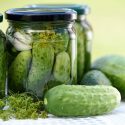What is Sodium Bisulfite (E222) in food? Property, Uses, Safety and More

Production | Uses | Safety | FAQs
Sodium bisulfite (SBS), also known as sodium bisulphite or sodium hydrogen sulfite, one of the sulfites that can be used as a preservative, antioxidant and anti-browning agent in food with the European food additive number E222.
How is Sodium Bisulfite made?
Sodium bisulfite can be commercially produced from the chemical reaction between sulfur dioxide gas with aqueous sodium hydroxide.
The following is the reaction equation:
SO2 + Na2CO3 (aqueous) –> 2 NaHSO3 + 2 CO2 (in water)
NaHSO3 is not a pure ingredient, and in fact a mixture of NaHSO3 and Na2S2O5 (sodium metabisulfite). Na2S2O5 is produced during the crystallization process of NaHSO3.
The main impurity in the product is SO42 -, as the bisulfite ion is unstable and easily oxidized to sulfate ion, so its solution cannot be stored for a long time.
Properties
| Other names | Sodium bisulphite, Sodium hydrogen sulphite, Sodium acid bisulfite |
| CAS number | 7631-90-5 |
| Chemical formula | NaHSO3 |
| Molecular weight | 104.06 |
| Boiling point | 315°C |
| Melting point | 150°C |
Appearance
- Solid: white granular or powder with an odour of sulfur dioxide.
- Liquid: A clear, colourless to yellow solution.
Solubility
Freely soluble in water, slightly soluble in ethanol. NaHSO3 is the main form of SO2 that dissolves in water. The equilibrium of its different inorganic forms (sulfur dioxide, bisulfite and sulfite ions) forms should be considered.
It is a weak acid that releases sulfur dioxide gas on heating or in the presence of acids.
It dissociates bisulfite (HSO3−) when dissolved in water and the aqueous solution is acidic with the PH 2.5-5.5 (10 % aqueous solution).
The following equilibriums exists after NaHSO3 dissolved in water:
HSO3- <===> H+ + SO32-
HSO3- + H2O <===> H2SO3 + OH
H2SO3 <===> SO2 + H2O
Structure

Image Source
What’re the Uses of Sodium Bisulfite?
Food
Generally, food grade sodium bisulfite can be used as an antimicrobial agent and antioxidant in food. It releases sulfur dioxide gas when added to water in acidic conditions, which functions as a preservative to kill microorganisms.
It can also be used as an oxygen scavenger which reacts with oxygen first and then prevents food spoilage from oxidation. And thus protects the color (anti-browning), freshness and flavor of food.
Fruits and vegetables
NaHSO3 is commonly used in the preservation of fruits and vegetables by preventing the enzymatic browning effect caused by polyphenol oxidase. Commonly used in fruit canning and leafy green vegetables.
Shrimp
The shrimp are often treated with sodium bisulfite to prevent or slow down the black spot formation (melanosis) in the head and shell of shrimp after being exposed to oxygen. Therefore, sodium bisulfite helps keep a good appearance for shrimp.
Cheese
Its function is to prevent the browning caused by Maillard reaction in the manufacturing of processed cheese at high temperatures.
Corn starch
Sodium bisulfite can be used to soften corn kernels, reduce the mechanical strength of corn kernels, and thus enable fiber and protein easily separated from starch.
It is an acidic salt, which is more stable than sulfurous acid in an aqueous solution.
Pharmaceuticals
Certain ingredients in some drugs are easily oxidized, and its purpose is used as an antioxidant to improve their stability.
Agriculture
In agriculture, it can be used to increase the photosynthesis rate and therefore increase fruit output.
Spraying sodium bisulfite during the period of fruit growth can increase the chlorophyll content by reducing sulfur to sulfhydryl (-SH), accelerate the photosynthetic rate by inhibiting the activity of glycolate oxidase and reducing the release of carbon dioxide, promote the accumulation of photosynthetic products in the fruit, and thereby increase the fruit weight gain rate.
Industrial
Industrial grade sodium bisulfite is widely used in the bleaching of cotton fabrics, and is also used as a reducing agent in the dye, paper, leather, and some other chemical synthesis.
Water treatment
NaHSO3 can be used as a mild reducing agent for wastewater chlorination. It is used to remove the residual chlorine in wastewater after chlorine has been used for adequate contact time for disinfection.
The following is the reaction mechanism with hypochlorous acid:
2NaHSO3 + 2HOCl –> H2SO4 + 2HCl + Na2SO4
It can also be used to remove bromine and iodine.
Is Sodium Bisulfite Safe to Eat?
Yes, it almost has no side effects and the safety has been approved by the U.S. Food and Drug Administration (FDA) and European Food Safety Authority (EFSA), as well as the Joint FAO/WHO Expert Committee on Food Additives (JECFA).
FDA
Sodium bisulfite is generally recognized as safe (GRAS) when used as a preservative, but banned in meats, foods recognized as a source of vitamin B1 and raw/fresh fruits or vegetables. (1)
EFSA
Sodium bisulfite (E222) is listed in Commission Regulation (EU) No 231/2012 as an authorised food additive and categorized in “ additives other than colours and sweeteners” (2).
Safety re-evaluation in 2016
EFSA concluded sodium bisulfite did not raise genotoxicity concerns when used as a food additive based on the available genotoxicity data, and established the temporary group ADI of 0.7 mg expressed as SO2 equivalent/kg bw per day for E220-E228. (3)
Approved uses
Its food applications are listed together with other sulfites (sulfur dioxide (E220), sodium sulfite (E221), sodium bisulfite (E222), potassium metabisulfite (E224), calcium sulfite (E226), calcium bisulfite (E227) and potassium bisulfite (E228) and with the maximum use levels “10-2000 mg/kg”. (4)
UK Food Standards Agency
Categorized in “Preservatives” (5)
Food Standards Australia New Zealand
It is an approved ingredient in Australia and New Zealand with the code number 222. (6)
JECFA
Function Class: food additives, antioxidant, preservative. (7)
Acceptable daily intake: ADI “0-0.7 mg/kg bw” expressed as sulfur dioxide set in 1998. (8)
Frequently asked questions
Sodium metabisulfite vs sodium bisulfite?
The latter solution can be used to produce the former. The details of their comparison please see in the article of sodium metabisulfite.
Sodium bisulfite vs sodium bisulfate?
The main differences are as follows: the latter is a stable ingredient with a neutral PH, and cannot be used as a preservative and antioxidant.
Is sodium bisulfite acid or base?
It is an acid as it can dissociate H+, but can also be considered as the base of H2SO3.
Is it gluten free?
Yes, it is gluten free that complies with the FDA’s definition of gluten free, that it does not contain wheat, rye, barley, or crossbreeds of these grains.
What’re the possible Side Effects of Sodium bisulfite?
Some people may be sensitive to sodium bisulphite and may irritate eyes, skin, and mucous membrane. (9)
Is it Vegan?
Yes, it is vegan as the raw materials and the manufacturing process without the use of animal matter or products derived from animal origin.
Conclusion
Now you may have a knowledge of the antioxidant & preservative – Sodium bisulfite (E222), from the following aspects:
- Manufacturing process
- Property
- Uses in fruits and vegetables, shrimp, cheese, corn starch, pharmaceuticals, water treatment and so on.
- Safety
- FAQs: compare with sodium metabisulfite and sodium bisulfate and etc.
What kinds of food labels have you found this ingredient in? Or if you have any questions or remarks about this additive, feel free to let me know in the comments.



Hiii…
Can we use this(E222) as a preservative in poultry industry?
Hi Khalid,
Whether you can use it or not, based on the guidelines of government.
I was told that sodium bisulfite has been shown to possibly cause colorectal cancer. Is this true?
Which authority did you hear this information from?
Can I use sodium bisulfate (E222?) in sauages? Please
I found sodium bisulfate listed in the ingredients for my instant mashed potatoes as a preservative.
Speaking from first hand experience, An intolerance to sodium bisulfite can cause swelling of face, lips and tongue. It can cause shortness of breath resulting in asthma. In fact, my allergist suspected that I had this intolerance and tested me using lemonade made with RealLemon brand of bottled concentrate lemon juice. After two sips 15 minutes apart, I was having difficulty breathing and had to use Albuterol to counteract the attack. I have found sodium bisulfite in most instant and frozen potatoes. Ore-Ida is an exception in some of theirs. Coconut, frozen seafood, cherry danish, brown gravy mix,
Maraschino cherries, margarita mixes, and other prepared frozen meals often have this andditive. Over the past few years some manufacturers have turned to other preservatives. I have to read the ingredients on all foods. Benadryl seems to help if you have a reaction.